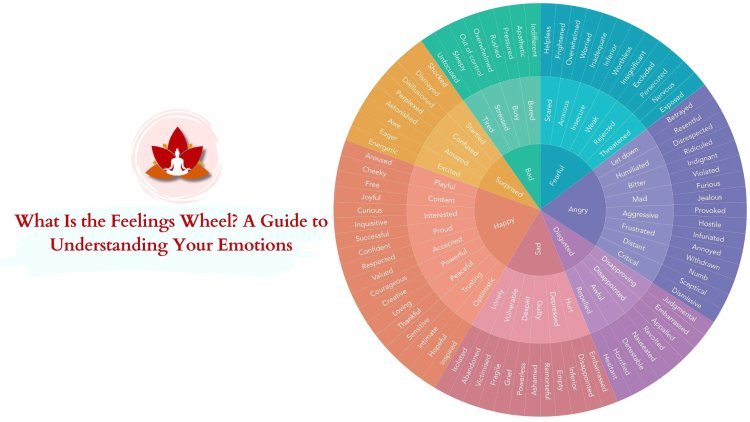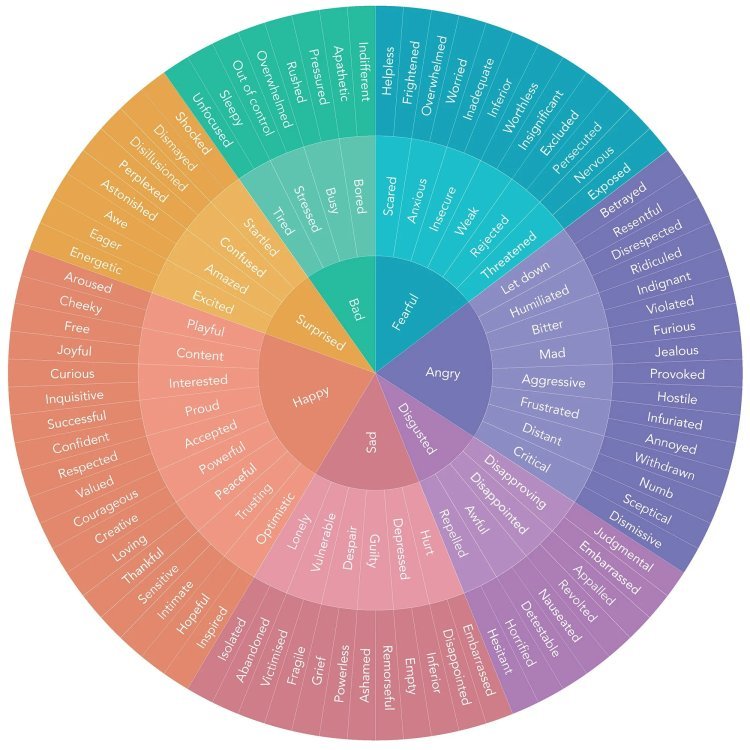The Feelings Wheel: Unlock the Power of Your Emotions for Personal Growth

Learn how to recognize and manage your emotions, deepen your self-awareness, improve emotional communication, and nurture your well-being with the Feelings Wheel.
Sometimes emotions arrive in powerful waves—loud, intense, and overwhelming. Other times, they are quiet, subtle, and hidden beneath the surface. For example, when you feel angry or frustrated, it can be difficult to pinpoint exactly what’s going on inside. Having a guide with different options can help you identify the precise emotion you’re experiencing.
Created by Dr. Gloria Willcox, the Feelings Wheel is a practical and insightful tool that helps us put words to our emotions. By learning to label feelings more accurately, we take an important step toward caring for our mental and emotional well-being.
What is the Feelings Wheel?

The Feelings Wheel is a simple yet powerful tool designed to help people identify and name their emotions more accurately. By offering a structured way to explore feelings, it supports the development of emotional intelligence and helps individuals navigate their inner world with greater clarity.
Origin of the Feelings Wheel
The Feelings Wheel was created in 1982 by Dr. Gloria Willcox, a psychologist who recognized the need for a tool that could make it easier for people to express their emotions. At the time, many struggled to articulate how they felt, often resorting to broad or vague terms like “angry” or “sad.” Dr. Willcox’s wheel provided a systematic and accessible framework for naming emotions with precision.
Her work built on earlier research by Robert Plutchik, who in 1980 introduced the Emotion Wheel based on his theory of emotions. Plutchik’s model illustrated how emotions are interconnected and how complex feelings emerge from basic emotional states. While his theory laid the scientific groundwork, Dr. Willcox simplified the concept into a practical tool for everyday use—the Feelings Wheel—making it easier for anyone to examine, understand, and communicate their emotions.
Structure of the Feelings Wheel
The Feelings Wheel is organized into concentric circles that represent different levels of emotional complexity:
-
Center of the Wheel – Core emotions such as joy, anger, sadness, fear, surprise, and love. These are the building blocks of emotional experience.
-
Middle Ring – Secondary emotions that expand on the core feelings. For example, anger may branch into frustration or jealousy.
-
Outer Ring – Tertiary emotions, which provide even more specific descriptions, such as agitation, resentment, or pride.
This layered design encourages people to move outward from a broad emotional state to a more precise description of what they’re truly experiencing.
The color coding and gradients of the wheel also highlight how emotions can blend, reminding us that feelings are not always isolated but often overlap and evolve.
A Multidisciplinary Approach
Dr. Gloria Willcox’s Feelings Wheel draws inspiration from psychology, neuroscience, and linguistics, making it a comprehensive tool for both personal reflection and professional practice. By bridging scientific insights with practical usability, the wheel has become a cornerstone in the fields of therapy, coaching, education, and self-development.
How Does the Feelings Wheel Work?
The Feelings Wheel works by breaking down emotions into categories and subcategories, helping us pinpoint exactly what we’re experiencing—even when feelings feel overwhelming or confusing. By moving through its structured layers, we can go from broad emotions to specific ones, gaining clarity and a deeper understanding of ourselves.
The design of the Feelings Wheel resembles a color wheel with concentric circles, each circle representing a different layer of emotional complexity:
1. Primary Emotions (Innermost Ring)
At the center of the wheel are the basic emotions—the foundation of our emotional experience. These include feelings like happiness, sadness, anger, fear, love, and surprise.
They give us a general sense of how we’re feeling and serve as the starting point for exploring deeper layers of emotion.
2. Secondary Emotions (Middle Ring)
The next layer of the wheel expands these core emotions into more detailed interpretations. For example:
-
Under anger, you might find frustration, annoyance, or resentment.
-
Under happiness, you may encounter excitement, pride, or optimism.
This level acknowledges that our emotions are rarely simple—they often emerge as a blend of different states.
3. Tertiary Emotions (Outer Ring)
The outermost circle identifies the most refined and specific feelings. These are subtle variations that distinguish one emotional experience from another. For example:
-
Under frustration, you might discover impatience, agitation, or exasperation.
-
Under sadness, you might find loneliness, disappointment, or melancholy.
By drilling down into these nuanced emotions, the Feelings Wheel helps us describe experiences with greater precision, which can be especially powerful for emotional communication and self-awareness.
Why Use the Feelings Wheel?
The Feelings Wheel serves as a map for navigating the complex world of human emotions. It helps you dig deeper into what you’re truly experiencing, verbalize your feelings with precision, and process them in a healthier way. Whether you’re seeking personal growth, stronger relationships, or mental health support, this tool offers multiple benefits.
1. Improves Emotional Communication
Clear and precise expression of emotions is essential for healthy relationships. The Feelings Wheel helps you communicate how you truly feel, breaking down vague terms like “angry” or “sad” into more specific emotions such as frustrated, resentful, or lonely. By expressing yourself more accurately, you allow loved ones, colleagues, or therapists to understand and respond with greater empathy.
2. Promotes Mindful Self-Reflection
The wheel acts like a mirror, reflecting the rich variety of emotions within you. As you move through its layers, you may uncover feelings you hadn’t recognized before. This mindful awareness fosters self-discovery and helps you understand how your emotions influence your thoughts and actions.
3. Supports Emotional Regulation
Identifying your emotions is the first step in managing them. Once you can name what you’re feeling, you can apply healthy coping strategies such as mindfulness, journaling, relaxation practices, or engaging in activities that address your emotional needs. The Feelings Wheel empowers you to move from reactivity to intentional response.
4. Reveals Emotional Patterns and Triggers
By consistently using the Feelings Wheel, you can notice patterns in your emotional reactions. It can help you identify triggers and validate your experiences, even in environments where certain emotions may feel stigmatized. This awareness creates a sense of empowerment and encourages non-judgmental acceptance of your feelings.
5. Enhances Mental Health Support
Therapists and counselors often use the Feelings Wheel as a practical tool in sessions. It helps clients articulate their emotions more clearly, opening deeper discussions and supporting the development of emotional intelligence. In turn, this can lead to more effective coping mechanisms and improved therapeutic outcomes.
6. Builds Empathy and Emotional Intelligence
As you explore emotions beyond your own, the wheel broadens your perspective and helps you connect with others on a deeper level. By recognizing the subtle range of feelings people experience, you cultivate empathy—an essential ingredient for strong relationships and meaningful communication.
How to Use the Feelings Wheel
The Feelings Wheel is more than just a colorful diagram—it’s a practical tool that can help you build emotional intelligence, deepen self-awareness, and strengthen your ability to communicate. Here’s how you can use it effectively:
1. Download or Print the Feelings Wheel
Start by having a copy of the Feelings Wheel handy. You can print it or save it on your phone for quick access whenever you’re struggling to identify your emotions.
Tip: Try coloring or highlighting different areas of the wheel—it’s a simple way to become familiar with the words and reflect on your emotional vocabulary.
2. Check in with Yourself
Pause, take a few deep breaths, and notice what’s happening in your body. Do you feel tension, heaviness, or restlessness? Then shift your attention to your emotions—are you on the verge of tears, wanting to hide, or ready to shout?
Scan the wheel and find the word that best describes your emotional state. Start with the core emotion (sadness, anger, joy, fear, etc.) and then move outward to refine your feeling—for example, sadness → lonely → isolated.
This process helps you move beyond vague emotions into precise awareness, the foundation of emotional intelligence.
3. Express Your Emotions
Once you’ve identified your feelings, put them into words. You can express them privately in a journal, or share them with a partner, friend, or therapist. Naming emotions clearly helps you feel understood—and allows others to connect with your experience more deeply.
4. Take Appropriate Action
Labeling your emotions gives you insight into what’s causing them. From there, you can take intentional action—whether that’s practicing mindfulness, setting a boundary, resting, or seeking support. By understanding your emotions, you’re less likely to react impulsively and more able to respond wisely.
Everyday Applications of the Feelings Wheel
Daily Check-ins
Using the Feelings Wheel regularly creates an honest dialogue with yourself (and others). It’s especially powerful after emotionally charged events, helping you make sense of what happened and how you truly feel. Over time, these check-ins reveal emotional patterns and triggers, leading to greater self-awareness.
Counseling and Therapy
Therapists often use the Feelings Wheel as a tool to help clients articulate and explore emotions. Clients can even rate the frequency or intensity of emotions, giving therapists valuable insights. This shared language strengthens the therapeutic relationship and supports emotional healing.
Personal Growth and Self-Reflection
For personal development, the Feelings Wheel is a life-changing tool. It helps you recognize emotional triggers, track recurring patterns, and cultivate healthier coping mechanisms. By reflecting daily, you can increase emotional intelligence, strengthen resilience, and nurture overall well-being.
The Feelings Wheel FAQs
Q: What is the Feelings Wheel?
The Feelings Wheel, developed by Dr. Gloria Willcox, is a tool that helps us label and understand our emotions. At times, feelings can feel overwhelming and intense, while at other times they’re subtle and hidden. For example, if you feel angry or frustrated, it may be hard to narrow it down to one word. The Feelings Wheel gives you multiple options, making it easier to pinpoint exactly what’s happening inside.
Q: How can I use the Feelings Wheel?
The Feelings Wheel is more than just a visual chart—it’s a guide to building emotional intelligence. Its concentric circles start with primary emotions and expand into secondary and tertiary ones, helping you move from general feelings to very specific ones. You can use it for:
-
Personal check-ins – understanding your current emotional state.
-
Communication – expressing yourself clearly to loved ones, colleagues, or therapists.
-
Journaling or self-reflection – writing down and exploring your emotions with greater depth.
Q: What is the Feelings Wheel most suitable for?
The Feelings Wheel is particularly useful for communication, as it helps break down emotional barriers and encourages open dialogue. Beyond that, it also supports:
-
Emotional intelligence – identifying and managing your feelings.
-
Empathy – recognizing emotions in others.
-
Self-reflection – gaining insight into your own patterns and triggers.
-
Emotional regulation – learning healthier ways to respond to feelings.
Q: Are there any disadvantages to using the Feelings Wheel?
There are very few downsides to identifying and expressing emotions. However, for some people, naming feelings may initially feel overwhelming or even anxiety-inducing—especially if strong or painful emotions surface. In such cases, it can be helpful to use the Feelings Wheel with the support of a therapist or counselor, who can guide you through the process in a safe and supportive environment.
What's Your Reaction?


























